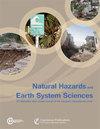Fixed photogrammetric systems for natural hazard monitoring with high spatio-temporal resolution
IF 4.7
2区 地球科学
Q1 GEOSCIENCES, MULTIDISCIPLINARY
引用次数: 0
Abstract
Abstract. In this publication we address the lack of technical expertise in the geoscience community in the design and construction of photogrammetric systems for monitoring natural hazards at high spatio-temporal resolution. Accordingly, we provide in-depth information on the components, assembly instructions, and programming codes required to build them, making them accessible to researchers from different disciplines who are interested in 3D change detection monitoring. Each system comprises five photographic modules and a wireless transmission system for real-time image transfer. As an alternative to lidar (light detection and ranging), high-end digital cameras offer a simpler and more cost-effective solution for the generation of 3D models, especially in fixed time-lapse monitoring systems. The acquired images, in combination with algorithms that allow the creation of improved 3D models, offer change detection performance comparable to lidar. We showcase the usefulness of our approach by presenting real-world applications in the field of geohazard monitoring. Our findings highlight the potential of our method to detect pre-failure deformation and identify rockfalls with a theoretical change detection threshold of only 3–4 cm, thereby demonstrating the potential to achieve similar accuracies to lidar but at a much lower cost. Furthermore, thanks to the higher data acquisition frequency, the results show how the overlap of events that leads to an erroneous interpretation of the behaviour of the active area is minimized, allowing, for example, more accurate correlations between weather conditions and rockfall activity.用于高时空分辨率自然灾害监测的固定摄影测量系统
摘要在本出版物中,我们解决了地球科学领域在设计和建造用于高时空分辨率监测自然灾害的摄影测量系统方面缺乏技术专长的问题。因此,我们提供有关组件,组装指令和编程代码所需的深入信息,使它们能够访问来自不同学科的研究人员,他们对3D变化检测监测感兴趣。每个系统包括五个摄影模块和一个用于实时图像传输的无线传输系统。作为激光雷达(光探测和测距)的替代品,高端数码相机为生成3D模型提供了更简单、更具成本效益的解决方案,特别是在固定的延时监控系统中。获取的图像,结合算法,允许创建改进的3D模型,提供可媲美激光雷达的变化检测性能。我们通过展示地质灾害监测领域的实际应用来展示我们的方法的有用性。我们的研究结果强调了我们的方法在检测破坏前变形和识别岩崩方面的潜力,理论变化检测阈值仅为3-4厘米,从而证明了实现与激光雷达相似精度的潜力,但成本要低得多。此外,由于更高的数据采集频率,结果显示了导致对活动区域行为错误解释的事件重叠如何被最小化,例如,允许在天气条件和岩落活动之间更准确的相关性。
本文章由计算机程序翻译,如有差异,请以英文原文为准。
求助全文
约1分钟内获得全文
求助全文
来源期刊
CiteScore
7.60
自引率
6.50%
发文量
192
审稿时长
3.8 months
期刊介绍:
Natural Hazards and Earth System Sciences (NHESS) is an interdisciplinary and international journal dedicated to the public discussion and open-access publication of high-quality studies and original research on natural hazards and their consequences. Embracing a holistic Earth system science approach, NHESS serves a wide and diverse community of research scientists, practitioners, and decision makers concerned with detection of natural hazards, monitoring and modelling, vulnerability and risk assessment, and the design and implementation of mitigation and adaptation strategies, including economical, societal, and educational aspects.

 求助内容:
求助内容: 应助结果提醒方式:
应助结果提醒方式:


